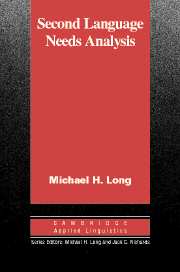Book contents
- Frontmatter
- Contents
- List of contributors
- Acknowledgments
- Overview: A rationale for needs analysis and needs analysis research
- I Methodological issues
- II The public sector
- III The occupational sector
- IV The academic sector
- Chapter 8 A task-based needs analysis of a tertiary Korean as a foreign language program
- V Analyzing target discourse
- Index
Chapter 8 - A task-based needs analysis of a tertiary Korean as a foreign language program
Published online by Cambridge University Press: 25 January 2010
- Frontmatter
- Contents
- List of contributors
- Acknowledgments
- Overview: A rationale for needs analysis and needs analysis research
- I Methodological issues
- II The public sector
- III The occupational sector
- IV The academic sector
- Chapter 8 A task-based needs analysis of a tertiary Korean as a foreign language program
- V Analyzing target discourse
- Index
Summary
Introduction
In 2002, a research team at the University of Hawai'i's National Foreign Language Resource Center (UH NFLRC) completed a threeyear, federally funded pilot project on a task-based approach to the teaching of Korean as a foreign language (KFL). The project covered all six components in the design, implementation, and evaluation of a Task-Based Language Teaching (TBLT) program (Doughty & Long, 2002; Long, 2000; Long & Norris, 2000): needs analysis; syllabus design; materials development; methodology and pedagogy; testing; and evaluation. Deliverables from the project included instruments and procedures for each component in both Korean and English, the latter intended as models for potential use in the teaching of other commonly and less commonly taught languages. This paper describes Stage 1 of the project, completed in the academic year 1999–2000: a task-based analysis of learners' target language needs, along with an illustration of the use of target discourse samples, collected as part of the needs analysis, in a module of task-based teaching materials. While some data are presented from the Korean study, the emphasis throughout is a practical demonstration of one process by which a task-based needs analysis (NA) can be carried out for any tertiary foreign language program. Since it was not the intention of the project at this time to develop an entire curriculum, only a selection of identified target needs was focused on to develop prototype taskbased instruction.
- Type
- Chapter
- Information
- Second Language Needs Analysis , pp. 225 - 262Publisher: Cambridge University PressPrint publication year: 2005
- 21
- Cited by



